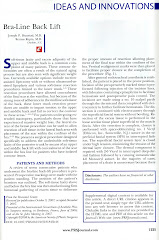What is Tummy Tuck Revision?
Many of the emails and questions I receive are from individuals who have had a tummy tuck and now are wondering how to fix or improve their tummy tuck result. The terms used for the group of procedures used to improve tummy tuck results includes "Tummy Tuck Revision", "Tummy Tuck Repair", and "Tummy Tuck Re-do". Regardless of which term we use we are communicating the same thing: surgical and non-surgical methods of improving the appearance of the abdomen and surrounding areas of the body following a tummy tuck. There are a handful of issues that can arise following a tummy tuck which can result in dissatisfaction with the appearance of the abdomen. A list of the more commonly encountered issues following a tummy tuck procedure is listed below:
List of potential tummy tuck issues:
Poor scars: Tummy tuck scars can be improved. Wide scars can be made thin by simple scar revision. Scars that are too high can be lowered by scar revision as well; however significant lowering of scars often requires full tummy tuck revision.
Belly button/umbilicus: There are many potential problems with the appearance of the belly button following a tummy tuck. Visible scars, a belly button that is asymmetric, too much fullness surrounding the belly button, a belly button that is either too small or too large or whose shape is unappealing can be corrected. Sometimes the solution can be fairly straightforward and even accomplished in the office under local anesthesia. Other belly button problems may require more extensive repair such as re-tightening of the abdominal wall and revising the tummy tuck to allow complete rejuvenation of the umbilicus.
Excess fat: Visible amounts of fat especially near the belly button and above the pubic bone can detract from the aesthetic result of a tummy tuck. Liposuction is often a great solution if there is not excess skin laxity. Localized pockets of fat can be performed under tumescent (local) anesthetic, more extensive liposuction is usually performed under general anesthesia.
Excess skin laxity: There are various reasons to have residual skin laxity following a tummy tuck. If the amount of excess skin laxity is relatively minor this can be corrected as part of a scar revision. Larger amounts of residual skin laxity may benefit from a formal tummy tuck revision or from the addition of a complimentary tummy tuck procedure such as a reverse tummy tuck following a traditional full tummy tuck.
“Dog-ears”: This term applies to excess skin and fat at the sides of the tummy tuck incision. They look like triangles of soft-tissue and are uniformally hated by any patient that have them. This is a result of several issues often it is a combination of too much laxity for the given tummy tuck procedure and/or the design of the incision and resection of the tummy tuck tissue. Correction of this problem can be accomplished in one of two ways. Either the excess soft-tissue is removed and the scar is lengthened thereby improving the overall appearance of this area, or the previous tummy tuck procedure is extended into a circumferential tummy tuck. This has the added benefit of improving the laxity that may exist at the side of the hips as well as in the buttock area for some patients.
Uneven surface: The surface of the abdomen should be smooth and natural. Lumps and bumps detract from the overall result and should be addressed. Small irregularities can be addressed with liposuction, larger irregularities should be addressed through a methodical assessment and correction usually requiring a formal revision tummy tuck.
Pseudobursa: A pseudobursa is a pocket of extra thick scar tissue that can form under the abdominal soft tissue following a tummy tuck. The most common area for pseudobursa formation is just above the waistline incision in the middle. This is the most gravity dependant area so it is naturally the most likely area for pseudobursa formation to occur. A pseudobursa can also develop just above the belly button. The presence of the belly button stalk and the surrounding tissue can form an area for a seroma to accumulate and for a pseudobursa to form. Small or relatively thin pseudobursa, if palpable or visible can be reduced by thorough liposuction and drain placement, most pseudobursas, however, need to be removed surgically during a revision tummy tuck for definitive correction.
All the best,
Dr. Remus Repta







